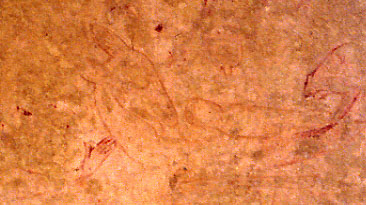Newton Green, Suffolk (†St Edmundsbury & Ipswich) Early C.14
Annunciation, Visitation, Nativity

At the far left is Gabriel, hands held out and apart to signify discourse. A stylised tree separates him from the Virgin Mary, who acknowledges his salutation with a raised hand and holds a book in the other. Further right, beyond another tree, a second angel is apparently leaving the scene. I do not think this is Gabriel shown a second time. This angel’s horizontally striped robe is markedly different, and I think the stripes are there to emphasise a distinction between the two. Since this angel is heading right, towards an area of wall now devoid of plaster, it seems very likely that a second scene began here, and there are in fact a few traces of pigment on the wall. The Visitation and Nativity are beyond the blank area, so the scene most likely to have been here originally is the Appearance of the Angel to Joseph¹

At the left of the photograph on the left is the Visitation, with Mary – probably the slightly taller of the two figures – embracing her cousin Elizabeth. Very faint beyond this is a Nativity scene. The main problem here lies in deciding whether the dominant feature in the scene is a striped bedcover hanging down the side of a bed, or the struts of a basket-manger full of hay.

On balance I think the latter is more likely, because the ‘stripes’ are rather too regular and linear for drapery, and the enlarged detail at the right shows, from the left, a hand, perhaps belonging to a midwife, the head of the Ass, a swaddled baby, and an outline in red faintly suggestive of a human head, but very possibly something else entirely, such as part of the Ox. If this is so, then the Ox, like the Ass, is looking at the infant Jesus in the manger. Since the scene almost certainly extended further to the right, onto another area of now blank wall where many other details might have appeared to fill out and continue the story, this uncertainty seems likely to remain.
Website for All Saints, Newton Green
¹ This subject is now very rare in English churches, but it appears in manuscript illustrations, and scenes of ‘Joseph’s Doubts’, including the Angel’s reassurance, were an enormously popular part of Mystery Play cycles. One now very indistinct wall painting of Joseph and the Angel, at Black Bourton in Oxfordshire, remains, and Tristram has a drawing of it as Plate 108A in his 13th century volume (Tristram II).